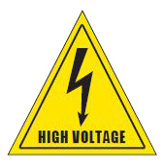How To Prevent Electrocution In The Warehouse
Hello and welcome to Premier Handling Solutions’ video series on running a safer and more efficient warehouse! Today we’re going to cover the importance of electrical hazards and ways to avoid them.
Although the risk of death by electrocution has fallen steadily since the 1980’s, there is still room for improvement. According to OSHA, 350 workplace fatalities are electrical related each year.
The top causes of electrocution fatalities are:
- Contact with overhead power lines
- Contact with live circuits
- Not following lock/tagout procedures
- Poorly maintained extension cords
- Defective power tools
A person can be injured five different ways from electrocution, broken down into two categories – direct and indirect injuries.
Direct injuries include electrocution or death due to electrical shock, electrical shock, and burns. Indirect injuries are from falls or fires.
Contact with power lines often occurs between cranes, ladders, scaffolds, backhoes, scissor lifts, dump trucks, and paint rollers.
How can you fix and prevent electrocution?
Proper training is the most important step to reducing your employees’ chances of being electrocuted. Only trained and authorized employees should work on electrical equipment.
Always keep yourself and surrounding areas dry. Throw away old and frayed power cords. Extension cords are a prime culprit when it comes to electrocution in a warehouse.
Clear your work space and walkways of cords. Foot and machine traffic can constantly rub a power cord and eventually damage it. A machine such as a forklift can run over or lift a power cord breaking it in two, which will cause severe injury or death. An employee tripping over a cord can result in a fall injury or electrocution if the cord happens to break.
Clearly mark all electrical hazards with high voltage signs and barriers. A warehouse that fails to clearly mark electrical hazards can be prosecuted for negligence.
Warehouse rubber mats are an excellent insulator and will prevent wearing cords under a mat. Since rubber mats can be cut to specific lengths, they are perfect for custom applications.
Use proper lock and tag procedures and devices. Always ensure a device isn’t live before trying to repair it. Ensure power tools are in proper working order, and replace tools when they show apparent wear. A tool with frayed power cords should no longer be used.
Thank you for stopping by to watch the Premier Handling Solutions’ video series on running a safer and more efficient warehouse. Remember, properly training and prevention are the keys to avoiding electrical injuries. Be sure to stop by often for more warehouse tips!

